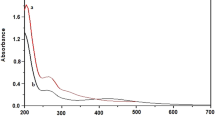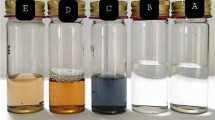Abstract
Antibacterial gauze is commonly used to prevent wound inflammation and infection. In this study, a novel antibacterial gauze was prepared using antimicrobial peptides and silver nanoparticles, achieving a wide antimicrobial spectrum and increased antimicrobial properties. The properties of the antibacterial gauze were analyzed by scanning electron microscopy, energy-dispersive spectrometry, weight gain rate test, Fourier transform infrared spectroscopy, antibacterial test, and cell activity test. The results of energy-dispersive spectrometry and Fourier transform infrared spectroscopy suggested that the antimicrobial peptides and silver nanoparticles were loaded on the surface of the gauze. The prepared gauze exhibited excellent antibacterial properties against Escherichia coli, Salmonella enteritidis, Staphylococcus aureus, and Bacillus cereus due to the synergistic antibacterial effect of the antimicrobial peptides and silver nanoparticles. Compared with antibacterial gauze loaded with high concentrations of silver nanoparticles, the gauze prepared here has better antimicrobial properties and no obvious cytotoxicity to cells. These results indicate that this antibacterial gauze, with good compatibility, is an attractive candidate for application in wound care and wound healing.










Similar content being viewed by others
References
Zhao X, Wu H, Guo B, Dong R, Qiu Y, Ma PX (2017) Antibacterial anti-oxidant electroactive injectable hydrogel as self-healing wound dressing with hemostasis and adhesiveness for cutaneous wound healing. Biomaterials 122:34–47
Novel bilayer wound dressing composed of silicone rubber with particular micropores enhanced wound re-epithelialization and contraction (2015). Biomaterials 40 (Complete):1–11
Souza JM, Henriques M, Teixeira P, Fernandes MM, Zille A (2019) Comfort and Infection Control of Chitosan-impregnated Cotton Gauze as Wound Dressing. Fibers Polym 20(5):922–932
Green and Sustainable Encapsulation of Guava Leaf Extracts (Psidium guajava L.) into Alginate/Starch Microcapsules for Multifunctional Finish over Cotton Gauze (2019). ACS Sustain Chem Eng 7(22):18612–18623
Chipoya MG (2012) Antimicrobial resistance in animal and public health: introduction and classification of antimicrobial agents. Rev Sci Tech 31(1):15
Abd Elsalam EA, Shabaiek HF, Abdelaziz MM, Khalil IA, El-Sherbiny IM (2020) Fortified hyperbranched PEGylated chitosan-based nano-in-micro composites for treatment of multiple bacterial infections. Int J Biol Macromol 148:1201–121. https://doi.org/10.1016/j.ijbiomac.2019.10.164
Gromadzka-Ostrowska J, Dziendzikowska K, Lankoff A, Mg D, Instanes C, Brunborg G, Gajowik A, Radzikowska J, Wojewódzka M, Kruszewski M (2012) Silver nanoparticles effects on epididymal sperm in rats. Toxicol Lett 214(3):251–258
Lakshmaiah Narayana J, Chen JY (2015) Antimicrobial peptides: Possible anti-infective agents. Peptides 72:S0196978115001680
Li Z, Liu X, Li Y, Lan X, Leung PH, Li J, Li G, Xie M, Han Y, Lin X (2016) Composite Membranes of Recombinant Silkworm Antimicrobial Peptide and Poly (L-lactic Acid) (PLLA) for biomedical application Scientific Reports 6 https://doi.org/10.1038/srep31149
Wang C, Chen X, Lao J (2020) Screening and Characterization of Ethanol-Producing Yeasts from Sewage Sludge, Soil and Rotten Fruits. J Biobased Mater Bioenergy 14(2):287–293. https://doi.org/10.1166/jbmb.2020.1960
Cai Q, Yang S, Zhang C, Li Z, Li X, Shen Z, Zhu W (2018) Facile and Versatile Modification of Cotton Fibers for Persistent Antibacterial Activity and Enhanced Hygroscopicity. Acs Applied Materials & Interfaces
Kundu SC, Sunaina S, Ghosh AK (2017) Non-immunogenic, porous and antibacterial chitosan and Antheraea mylitta silk sericin hydrogels as potential dermal substitute. Carbohydr Polym and Scientific & Technological Aspects of Industrially Important Polysaccharides
Epand RM, Walker C, Epand RF (1858a) Magarvey NA (2016) Molecular mechanisms of membrane targeting antibiotics. Biochim Biophys Acta 5:980–987
Epand RM, Walker C, Epand RF (1858b) Magarvey NA (2016) Molecular mechanisms of membrane targeting antibiotics. Biochim Biophys Acta-Biomembranes 5:980–987. https://doi.org/10.1016/j.bbamem.2015.10.018
Shen M, Dong W, Qian J, Zou L Antimicrobial activity and membrane interaction mechanism of the antimicrobial peptides derived from Rana chensinensis with short sequences. Biologia 72 (9)
Yount NY, Yeaman MR (2013) Peptide antimicrobials: cell wall as a bacterial target. Ann N Y Acad Sci 1277 (1)
Pouny Y, Rapaport D, Mor A, Nicolas P, Shai Y (1992) Interaction of antimicrobial dermaseptin and its fluorescently labeled analogs with phospholipid membranes. Biochemistry 31(49):12416–12423
Durán N, Durán M, De Jesus MB, Seabra AB, Fávaro WJ, Nakazato G (2015) Silver Nanoparticles: A New View on Mechanistic Aspects on Antimicrobial Activity. Nanomedicine Nanotechnology Biology & Medicine:S1549963415006000
Li WR, Xie XB, Shi QS, Zeng HY, Ou-Yang YS, Chen YB (2010) Antibacterial activity and mechanism of silver nanoparticles on Escherichia coli. Appl Microbiol Biotechnol 85(4):1115–1122
Kim SH, Inje University, Gimhae (2011) Antibacterial Activity of Silver-nanoparticles Against Staphylococcus aureus and Escherichia coli. Korean Journal of Microbiology & Biotechnology 39(1):77–85
Elmahdy MM, Eldin TAS, Aly HS, Mohammed FF, Shaalan MI (2015) Evaluation of hepatotoxic and genotoxic potential of silver nanoparticles in albino rats. Experimental & Toxicologic Pathology Official Journal of the Gesellschaft Für Toxikologische Pathologie 67(1):21–29
Luo K, Yang Y, Shao Z (2016) Physically Crosslinked Biocompatible Silk-Fibroin-Based Hydrogels with High Mechanical Performance. Adv Func Mater 26(6):872–880. https://doi.org/10.1002/adfm.201503450
Acknowledgments
This research was funded by grants from the National Natural Science Foundation of China (No. 31830094), Funds of China Agriculture Research System (No. CARS-18-ZJ0102), and the Innovation Program for Chongqing's Overseas Returnees (No. cx2019090).
Author information
Authors and Affiliations
Corresponding author
Additional information
Publisher’s Note
Springer Nature remains neutral with regard to jurisdictional claims in published maps and institutional affiliations.
Rights and permissions
About this article
Cite this article
Chen, L., Ai, J., Cai, H. et al. Antibacterial gauze based on the synergistic antibacterial mechanism of antimicrobial peptides and silver nanoparticles. J Polym Res 28, 32 (2021). https://doi.org/10.1007/s10965-020-02363-3
Received:
Accepted:
Published:
DOI: https://doi.org/10.1007/s10965-020-02363-3




